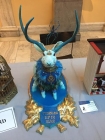The Second Annual Baltimore Taxidermy Open, presented by Bazaar Baltimore, was held at The Walters Art Museum this Thursday. The event featured a taxidermy competition with competitors from all over the country, a taxidermy demonstration with Divya Anantharaman, a book signing with author Robert Marbury and a lecture with Curator Joneath Spicer.
The works featured in the competition were anything but ordinary. From the fashionable, like the bone crowns on Risa Reyes, to the practical, such as Sarah Dolezol’s lamp made of bones and dried flowers, to the downright creative, like Emily Binard’s “Tangled Up In Blue”.

In her first demo of the night, Anantharaman showed the steps she takes when performing taxidermy on a bird, specifically a starling, which she said are especially interesting to work with because they change colors depending on the season.
Anantharaman described each step – from the initial incision, to the cleaning of the coat, to the mounting on the mold that she makes. While she was showing the bird before cleaning, she said, “This looks like a hot mess, because it pretty much is.”
Each portion was in a plastic bag which she passed around for the viewers to examine. The most intriguing part was the empty bird, after the skin had been clean. “Right now, the skin is flexible because I’ve had it in my fridge,” she apologized.
Her demonstration was also heavy in taxidermy care tips. She dusts her taxidermy once a week and suggests to keep pieces out of sunlight.
“It makes a really great Instagram photo, but it’s really bad for the taxidermy,” said Anantharaman.
After this, Joaneath Spicer, curator of Renaissance and Baroque art, gave a lecture in the auditorium about taxidermy history and the taxidermy displayed in the Chamber of Wonders, a gallery that she curated.
“The Chamber of Wonders represents this universal collecting urge,” she said as the gallery contains both natural specimens and works of art.
The talk began with Spicer focusing on one small figure in the Chamber of Wonders, called, “curiosity figure.” However, she refers to him as “seed man.” He is covered in seeds and made out of beeswax, pearls and rubies while his forehead is the stomach of a beetle.
Then, she detailed some of the history of taxidermy practice. In the 1600s, people performed taxidermy to preserve the natural world. This all changed when wealthy people began looking for specimens of creatures they had seen, mostly dragons.
According to Spicer, people would find these “dragons,” conveniently never alive, and would bring them to the patron. “Winged dragons were really in,” she said. Most of the time, they were stingrays that had been cut and reformed to look like whatever the person was looking for.
At the end of her talk, Spicer headed to the Chamber of Wonders to answer any questions that people had about the works displayed there.
The Baltimore Taxidermy Open concluded with an awards ceremony that took place in the sculpture court, where the competing works were displayed all night.
The event was littered with every curiosity imaginable and the crowd ranged from children to adults, all excited by the works that, while natural specimens, were truly out of this world.
